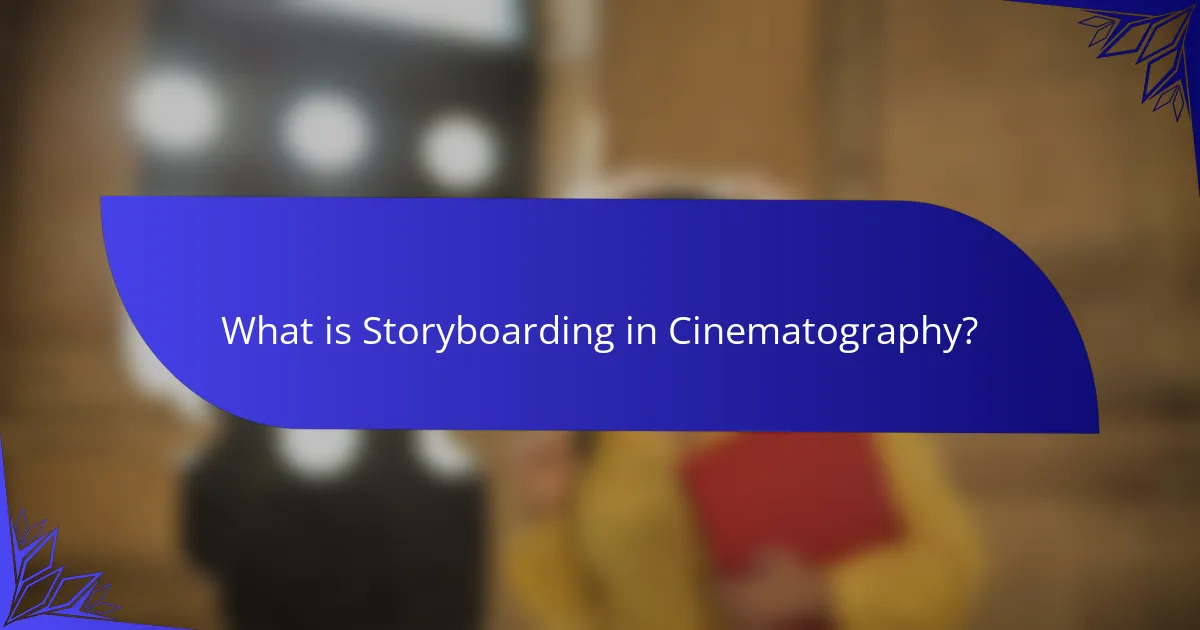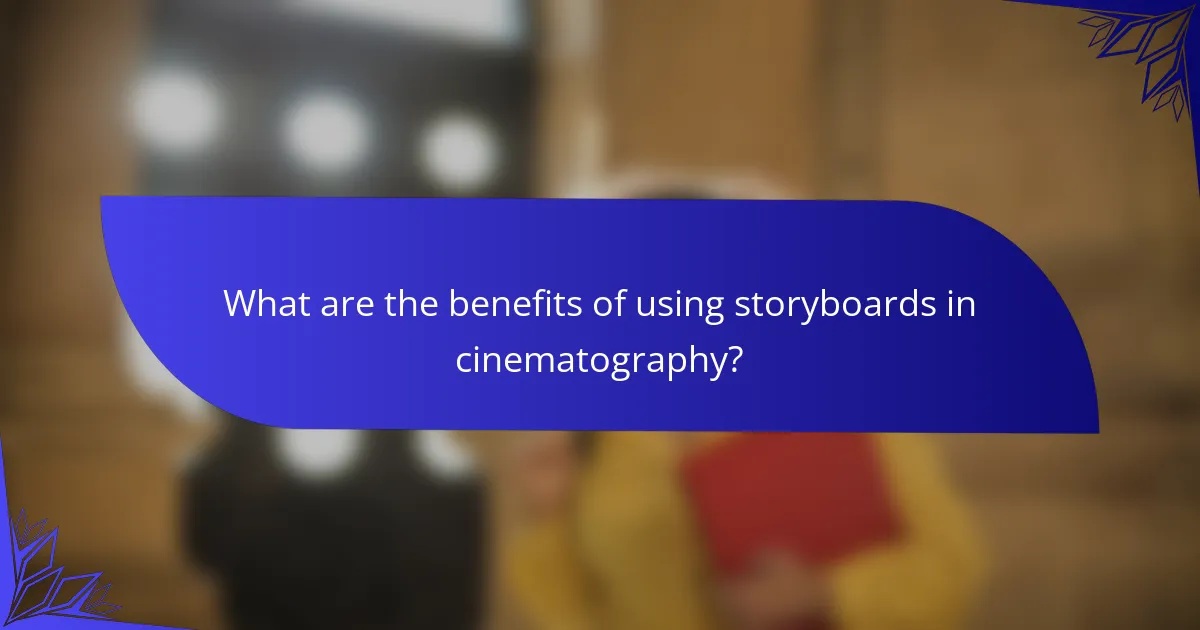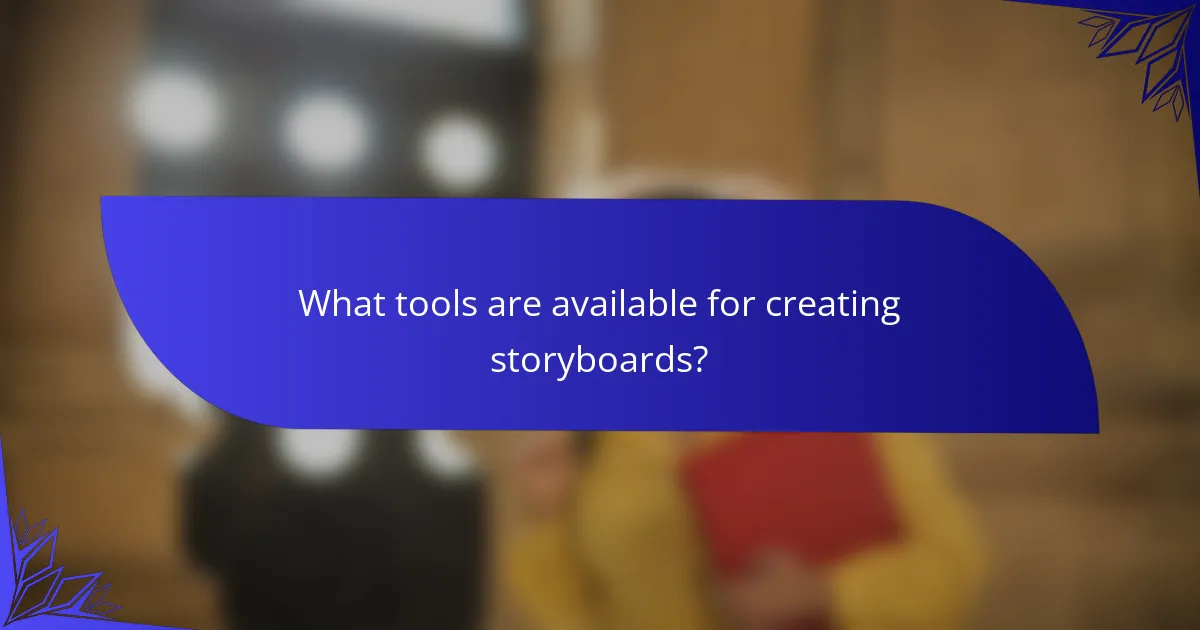Storyboarding is a crucial visual planning tool in cinematography that outlines a film’s scenes through a sequence of drawings or images representing each shot. This method enhances the narrative flow and composition, serving as a blueprint for the production process by illustrating key elements such as camera angles and character actions. Storyboarding improves communication among the production team, facilitates efficient time management, and helps identify potential challenges before filming begins. Various tools for creating storyboards, including software like Storyboard Pro and Celtx, as well as traditional methods like paper and pencil, cater to different needs in visual planning. The article explores the importance of storyboarding in cinematography, detailing its processes, benefits, and available tools.

What is Storyboarding in Cinematography?
Storyboarding in cinematography is a visual planning tool used to outline a film’s scenes. It involves creating a sequence of drawings or images that represent each shot. Storyboards help filmmakers visualize the narrative flow and composition. They serve as a blueprint for the production process. Each storyboard frame illustrates key elements such as camera angles and character actions. This method enhances communication among the production team. It also aids in identifying potential challenges before filming begins. Storyboarding is widely recognized as essential for effective cinematographic storytelling.
How does storyboarding contribute to the filmmaking process?
Storyboarding contributes to the filmmaking process by providing a visual representation of the narrative. It outlines scenes, sequences, and transitions in a structured format. This aids directors and cinematographers in visualizing the film before shooting. Storyboards help in planning camera angles and movements. They also facilitate communication among the crew. This ensures everyone understands the creative vision. Studies show that storyboarding can streamline production and reduce costs. For example, films that utilized storyboarding often encounter fewer shooting days.
What are the key elements of a storyboard?
The key elements of a storyboard include panels, visuals, and annotations. Panels represent individual scenes or shots. Each panel illustrates the action and composition. Visuals can include sketches, images, or photographs. Annotations provide details such as dialogue, camera angles, and notes on movement. These elements work together to convey the narrative structure. Effective storyboards enhance communication among the production team. They serve as a visual guide throughout the filmmaking process.
How is a storyboard different from a script?
A storyboard is a visual representation of a narrative, while a script is a written document detailing dialogue and actions. Storyboards consist of illustrations or images arranged in sequence. They help visualize scenes and camera angles. Scripts contain the narrative structure, character dialogues, and stage directions. The storyboard focuses on visual storytelling, whereas the script emphasizes dialogue and plot development. Storyboards aid in planning shots, while scripts guide performances. Together, they complement each other in the filmmaking process.
Why is storyboarding important for visual storytelling?
Storyboarding is important for visual storytelling because it provides a visual blueprint for the narrative. This process allows creators to plan scenes, transitions, and character actions in a structured way. By visualizing the sequence of events, filmmakers can identify pacing and flow issues early in production. Storyboards help communicate ideas clearly among team members, ensuring everyone shares the same vision. They also serve as a reference during filming, reducing ambiguity and confusion on set. Additionally, research shows that projects with storyboards are more likely to stay on schedule and within budget. Overall, storyboarding enhances creativity and efficiency in the filmmaking process.
How does storyboarding enhance communication among the film crew?
Storyboarding enhances communication among the film crew by providing a visual representation of the script. It allows crew members to understand the sequence of scenes clearly. Each frame illustrates camera angles, character movements, and key actions. This clarity reduces misunderstandings during filming. Crew members, such as directors and cinematographers, can reference the storyboard to align their visions. It also facilitates discussions among departments, ensuring everyone is on the same page. A study by the American Film Institute highlights that 75% of filmmakers find storyboards essential for effective communication. This statistic underscores the importance of storyboarding in the filmmaking process.
What role does storyboarding play in planning shots and scenes?
Storyboarding plays a crucial role in planning shots and scenes. It visually represents each scene in a sequence. This process helps filmmakers organize their thoughts and ideas. Storyboards clarify the narrative flow and pacing. They also assist in determining camera angles and movements. By illustrating scenes, storyboards facilitate communication among the production team. This visual tool can highlight potential issues before filming begins. Overall, storyboarding enhances efficiency and creativity in cinematography.

What are the benefits of using storyboards in cinematography?
Storyboards enhance cinematography by providing a visual plan for scenes. They help directors and cinematographers visualize the sequence of shots. This leads to improved communication among the production team. Storyboards also facilitate efficient time management during filming. They allow for better organization of scenes and camera angles. Additionally, they help identify potential issues before shooting begins. This proactive approach can save costs and reduce filming time. According to a study by the American Film Institute, 70% of filmmakers report increased efficiency when using storyboards.
How does storyboarding improve efficiency during production?
Storyboarding improves efficiency during production by providing a visual roadmap for filmmakers. It helps in organizing scenes and sequences clearly. This organization leads to better time management during shooting. Crew members understand their roles and responsibilities more effectively. It minimizes miscommunication and reduces the need for extensive revisions. According to a study by the University of Southern California, projects with storyboards finish 25% faster than those without. This efficiency translates to lower production costs and smoother workflows. Overall, storyboarding streamlines the entire production process.
What impact does storyboarding have on the budget?
Storyboarding significantly impacts the budget by providing a clear visual plan for production. This clarity helps in identifying necessary resources and minimizing unexpected costs. By outlining scenes in advance, storyboarding reduces the likelihood of costly reshoots. It also streamlines communication among the crew, which can lead to more efficient use of time and resources. A study by the University of Southern California found that projects with detailed storyboards can reduce production costs by up to 30%. Therefore, investing time in storyboarding can lead to significant budget savings overall.
How can storyboarding help in identifying potential challenges?
Storyboarding helps in identifying potential challenges by visually mapping out scenes. This visual representation allows creators to foresee logistical issues. For example, it highlights the need for specific locations or props. Additionally, storyboards can reveal pacing problems in the narrative. They facilitate discussions among the team, ensuring everyone is aligned. This alignment can uncover misunderstandings before production begins. By anticipating these challenges, teams can make necessary adjustments early. Research shows that effective storyboarding reduces production costs by minimizing last-minute changes.
What creative advantages does storyboarding offer?
Storyboarding offers several creative advantages in the filmmaking process. It provides a visual representation of scenes, allowing filmmakers to plan shots effectively. This planning helps in visualizing the narrative flow and pacing. Additionally, storyboarding facilitates communication among team members, ensuring everyone shares the same vision. It also aids in identifying potential issues before filming begins, saving time and resources. Research indicates that storyboarding can enhance creativity by allowing for exploration of different visual styles and compositions. By providing a clear roadmap, it enables filmmakers to focus on the storytelling aspects during production.
How does storyboarding aid in visualizing the narrative flow?
Storyboarding aids in visualizing the narrative flow by providing a sequential visual representation of scenes. This method allows filmmakers to organize their ideas and structure the story effectively. Each storyboard frame represents a key moment in the narrative. This visual outline helps identify pacing and transitions between scenes. By laying out the story visually, filmmakers can see how the narrative unfolds. It also facilitates communication among the crew about the intended vision. Research indicates that storyboarding can improve the efficiency of the production process. A study by the University of Southern California found that 70% of filmmakers reported better clarity in narrative flow when using storyboards.
What are the benefits of experimenting with visual styles through storyboards?
Experimenting with visual styles through storyboards enhances creativity and clarity in cinematography. It allows filmmakers to visualize scenes before production. This process aids in identifying the best visual approach for storytelling. By sketching different styles, creators can explore diverse aesthetics and compositions. Storyboards also facilitate communication among the production team. They provide a visual reference that aligns everyone’s understanding of the project. Additionally, experimenting can lead to innovative techniques that enhance the final product. Ultimately, these benefits contribute to a more cohesive and impactful cinematic experience.

What tools are available for creating storyboards?
Various tools are available for creating storyboards. Popular software includes Storyboard Pro, which offers advanced features for animatics and timing. Another option is Celtx, known for its collaborative capabilities and integration with scriptwriting. Photoshop is also widely used for custom illustrations. Additionally, online platforms like Boords facilitate easy sharing and editing. Traditional methods include paper and pencil for quick sketches. Each tool caters to different needs, from professional animation to simple visual planning.
What traditional methods are used for storyboarding?
Traditional methods for storyboarding include hand-drawn sketches and physical storyboards. Artists typically create sequential drawings to represent scenes. These sketches are often arranged on a board or wall. The arrangement helps visualize the flow of the story. Another method involves using index cards. Each card represents a scene or shot. This allows for easy reordering and adjustments. Additionally, some filmmakers use printed templates. These templates provide a structured approach for drawing scenes. Overall, these traditional methods have been effective for planning visual narratives.
What materials are commonly used in hand-drawn storyboarding?
Common materials used in hand-drawn storyboarding include paper, pencils, markers, and erasers. Storyboard artists typically use blank storyboard templates printed on paper. These templates help organize frames and scenes effectively. Pencils are essential for initial sketches due to their erasable nature. Markers are often used to add color and detail after the pencil work. Additionally, artists may use sketchbooks for more freeform storyboarding. Some professionals also utilize digital tablets for hand-drawn storyboarding. These tools enhance flexibility and ease of editing.
How can digital tools enhance the storyboarding process?
Digital tools can significantly enhance the storyboarding process by providing flexibility and efficiency. They allow for easy modifications of frames and scenes. This adaptability helps creators visualize changes quickly. Digital tools also facilitate collaboration among team members in real-time. Cloud-based platforms enable multiple users to access and edit storyboards simultaneously. Additionally, these tools often include templates and assets that save time. They can integrate with other software used in production, streamlining workflows. Research shows that using digital tools can reduce the overall time spent on pre-production tasks by up to 30%. This efficiency ultimately leads to a more organized and coherent storytelling process.
What are some popular software options for storyboarding?
Popular software options for storyboarding include Storyboard Pro, Celtx, and Adobe Photoshop. Storyboard Pro is widely used for its comprehensive features tailored for animators and filmmakers. Celtx offers cloud-based collaboration tools, making it ideal for team projects. Adobe Photoshop provides flexibility for artists who prefer a more hands-on approach to visual storytelling. These tools are favored in the industry for their unique capabilities and user-friendly interfaces.
How do different software tools compare in terms of features?
Different software tools for storyboarding vary significantly in features. Some tools focus on user interface simplicity, while others offer advanced functionalities. For instance, Storyboard Pro includes extensive drawing tools and timeline features. In contrast, Celtx emphasizes script integration and collaboration. Additionally, tools like FrameForge provide 3D visualization capabilities, enhancing pre-visualization. A comparison of features reveals that while some tools cater to beginners, others are designed for professional filmmakers. This diversity allows users to select software that best fits their specific needs in the storyboarding process.
What are the pros and cons of using online storyboard tools?
Online storyboard tools offer several advantages and disadvantages.
Pros include ease of collaboration. Multiple users can work simultaneously from different locations. This enhances creative input and speeds up the process. Additionally, these tools often provide templates, which simplify the storyboard creation. They also allow for easy revisions, making it simple to adjust scenes as needed.
Cons include potential technical issues. Users may experience software glitches or internet connectivity problems. Moreover, some online tools may have a learning curve. This can slow down the initial usage for new users. Lastly, reliance on technology can limit creativity for some individuals who prefer traditional methods.
What best practices should be followed when storyboarding?
Best practices for storyboarding include clearly defining the narrative structure. This helps in organizing scenes effectively. Utilize visual elements to convey emotions and actions. This enhances clarity and engagement. Maintain consistency in character design and settings. This ensures continuity throughout the storyboard. Incorporate annotations for dialogue and sound cues. This aids in understanding the flow of the story. Review and revise the storyboard regularly. This allows for improvements and adjustments as needed. Collaborate with the team for diverse perspectives. This can lead to more creative solutions.
How can filmmakers ensure their storyboards are effective?
Filmmakers can ensure their storyboards are effective by clearly defining each scene’s visual narrative. This involves detailing character positions, camera angles, and action sequences. Effective storyboards should also include annotations for dialogue and sound cues. Filmmakers should regularly review and revise storyboards to address any inconsistencies. Collaborating with the entire production team enhances clarity and alignment. Utilizing software tools can streamline the storyboard creation process. Research shows that detailed storyboards can improve communication and efficiency on set, leading to a smoother filming process.
What common mistakes should be avoided in the storyboarding process?
Common mistakes to avoid in the storyboarding process include insufficient detail in frames. Vague sketches can lead to misinterpretation during production. Another mistake is neglecting to consider pacing and timing. Storyboards should reflect the rhythm of the narrative. Failing to collaborate with the team is also detrimental. Input from directors, cinematographers, and editors is crucial for alignment. Overcomplicating scenes with excessive detail can hinder clarity. Simplicity often enhances communication of ideas. Lastly, ignoring revisions can result in missed opportunities for improvement. Continuous feedback is essential for a successful storyboard.
The main entity of this article is storyboarding in cinematography, a crucial visual planning tool that outlines a film’s scenes through a sequence of drawings or images. The article covers the significance of storyboarding in enhancing communication among production teams, improving efficiency, and identifying potential challenges before filming begins. It details the key elements of a storyboard, differentiates it from scripts, and explores its benefits for visual storytelling and budget management. Additionally, the article reviews various tools and best practices for creating effective storyboards, highlighting their role in the filmmaking process.